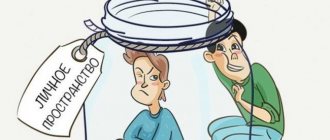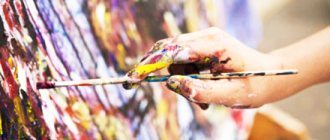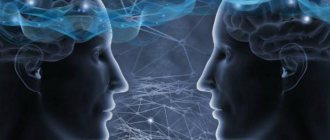Complexes, archetypes and the collective unconscious
Carl Gustav Jung is known as a follower of Freud who continued the development of psychoanalytic theory. True, he did not follow Freudian traditions, but went his own way. Therefore, their cooperation was not so long. The concept of the collective unconscious was the main reason for the differences in views between them.
Article on the topic 5 most famous psychological experiments of all time According to Jung, the structure of the personality (he called it the soul) consists of the Ego, the Personal Unconscious and the Collective Unconscious. The ego is what we used to call consciousness, or everything we mean when we say “I”. The personal unconscious is personal experience, for some reason forgotten or repressed, as well as everything that we don’t seem to notice around us. The personal unconscious consists of complexes - these are emotionally charged groups of thoughts, feelings and memories. Each of us has mother and father complexes - emotional impressions, thoughts and feelings associated with these figures and the scenarios of their life and interaction with us. A common power complex in our time is when a person devotes a lot of his mental energy to thoughts and feelings about control, dominance, duty, and submission. The inferiority complex, etc., is also well known.
The collective unconscious contains thoughts and feelings that are common to all people, the result of our common emotional past. As Jung himself said: “The collective unconscious contains the entire spiritual heritage of human evolution, reborn in the structure of the brain of each individual.” Thus, the collective unconscious is passed down from generation to generation and is common to all people. Examples include mythology, folk epic, as well as the understanding of good and evil, light and shadow, etc.
By analogy, just as complexes make up the content of the personal unconscious, the collective unconscious consists of archetypes - primary images that all people imagine in the same way. For example, we all react in approximately the same way to parents or strangers, death or a snake (danger). Jung described many archetypes, among which are the mother, the child, the hero, the sage, the rogue, God, death, etc. Much of his work is devoted to the fact that archetypal images and ideas are often found in culture in the form of symbols used in painting, literature and religion. Jung emphasized that symbols characteristic of different cultures often show striking similarities precisely because they go back to archetypes common to all humanity.
How is this applied today?
Today, this knowledge is widely used in the work of psychologists and psychotherapists of all directions. It’s quite difficult to underestimate the word “complex” or “archetype” in the work of a psychologist, would you agree? At the same time, the analyst does not label you, but knowledge about the nature and scenario of archetypes and your complexes helps to better understand your personal “psychic kaleidoscope.”
It both heals and cripples. How psychiatry developed
More details
Evidence from our time
For a long time it was believed that nothing except the genotype is physically transmitted from one person to another. Genes do not change from lifestyle. How else can information about the life of ancestors appear at the organism level?
It turned out that it could very well. This was shown by a study conducted in 2014, the results of which were published in Nature Neuroscience. Depending on what experience the mice had, their offspring behaved differently: their reactions differed from the control group of mice, they reacted to stimuli associated with the past of their ancestors, as if they themselves had experienced something similar to their parental experience in their lives .
We recommend: Depth Psychology
Scientists explained it this way: the genome indeed remains unchanged, but something changes: the expression of a particular gene associated with the experience of the parent mouse. The expression of a gene affects the sensitivity of certain cells in the body with which it is associated. And this in turn changes sensations, reactions and feelings.
There's something else worth adding. Firstly, the reaction to the stimulus that the first group of mice had was also observed in the grandchildren of these mice. Secondly, neither the second nor the third generation was presented with a repeated stimulus, but the reaction was still noticeable. But people have been exposed to similar strong stimuli for millions of years, so the reactions should only be strengthened.
All this was not known in Jung’s time, and he could hardly have foreseen such a turn of events. He believed that any experiments to prove the existence of the collective unconscious and its images were impossible.
Analytical psychology
After receiving a medical degree in psychiatry from the University of Basel, young Jung became an assistant in a clinic for the mentally ill under the direction of Eugene Bleuler, the author of the term “schizophrenia.” Interest in this mental illness led him to the works of Freud. Soon they met in person. Jung's education and depth of views made a tremendous impression on Freud. The latter considered him his successor, and in 1910 Jung was elected the first president of the International Psychoanalytic Association. However, already in 1913 they broke off relations due to differences in views on the unconscious, as I said above - Jung identified the collective unconscious, with which Freud did not agree, and also expanded and supplemented the concept of “complex” to the form in which it has survived to this day. And then Jung went on his own inner path. His autobiography, Memories, Dreams, Reflections, begins with the statement: “My life is the story of the self-realization of the unconscious.”
Article on the topic
I made a Freudian slip. What our mistakes, slips and forgetfulness will tell us As a result of this “self-realization of the unconscious”, Jung had a whole complex of ideas from such different fields of knowledge as philosophy, astrology, archeology, mythology, theology and literature and, of course, psychology, superimposed on his psychiatric education and Freud's ideas about the unconscious. The result was what is today called analytical psychology.
Plus, Jungians (as psychologists who adhere to Dr. Jung’s theory call themselves - analytical psychologists) actively use a range of other psychological methods: art therapy, psychodrama, active imagination, all types of projective techniques (such as analysis of drawings), etc. Jung was especially fond of art therapy - creativity therapy. He believed that through continuous creative activity one could literally prolong one's life. With the help of creativity (art therapy), any spontaneous types of drawing, especially mandalas (a schematic image or design used in Buddhist and Hindu religious practices), deep layers of the psyche are released.
How is this applied today?
Psychoanalysts around the world are divided into Freudians and Jungians. An orthodox Freudian psychoanalyst will place you on the couch, sit at the head of the bed and listen to you with a minimal presence, 2-3 times a week for 50 minutes. All visits, including missed ones, are paid. Time does not change or move, even if you work every other day and are unable to comply with agreements on your work schedule. But when you express a desire to find out why the analyst is so unfair to you and does not want to get into your position, you will be asked a couple of questions about why everything in your life is so inconvenient? And also who is usually inclined in real life to enter into your circumstances and adapt to you?
The Jungians approach things differently. As a rule, this is once a week, and the conditions can be negotiated and be more flexible. For example, sessions missed for valid reasons can be worked out at another time. It is not at all necessary to lie down on the couch; you can sit on armchairs and talk, as you are used to in everyday life. Also, in addition to the dialogue, you may be asked to comment on the image, fantasize out loud, and then draw your fantasy or feeling, imagine someone opposite you and talk to him, moving first to his place, then back to yours, they may be asked to make something something made of clay or sand...
The boundaries and rules of communication between the analyst and the patient still remain quite strict, which determines the quality of the contact and, accordingly, the work.
Today we can safely say that all areas of psychotherapy and practical psychology are rooted in analytical and projective practice. Thus, analytical psychology is something that combines basic knowledge of psychoanalytic practice, the collective centuries-old experience of people working with their inner world and its self-expression and modern achievements in the science of the soul - psychology.
Psychiatrist: “People are afraid of getting cancer, but almost no one is afraid of going crazy”
More details
Jung's archetype of the self
In 1912, after his break with Freud, Jung entered a period of deliberate, conscious collaboration with what he felt was the strongest pressure of his unconscious (even though he did not yet think of it as the “self”). The culmination of this period was in 1927, when he once dreamed that he was with a friend in Liverpool.
Jung writes:
“We came out into a wide square, dimly lit by street lamps. Many streets converged on the square, and city blocks were located around it in radii. In its center there was a round pond with a small island in the middle. While everything around was dim due to rain, foggy haze and poor lighting, the island shone in the sunlight. There was a lone tree on it, a magnolia, showered with pink flowers. Everything looked as if the tree was illuminated by the sun - and at the same time it itself served as a source of light.” (Jung, 1962, 223)
Jung comments:
“The dream reflected my state at that moment. I can still see the grayish-yellow raincoats glistening from the rain. The feeling was extremely unpleasant, everything around was dark and dim - that’s exactly how I felt then. But in the same dream a vision of unearthly beauty arose, and only thanks to it I could continue to live.” (ibid., 224)
Jung realized that for him, “the goal is the center, and everything is directed towards the center,” and the center is the self, “the principle and archetype of direction and meaning.” From this experience arose “the first hint of my personal myth,” of the psychic process towards individuation. (ibid.)
The archetype of the self is the organizing principle whose function is to integrate, unite, push towards the center all the infinite possibilities that exist in the psyche, and thus create a state of greater psychological wholeness. Later researchers note that, according to the theory of archetypes, the archetype of the self also includes the opposite pole: the predisposition of mental units to disintegration, confrontation or stagnation. This issue has been studied by two contemporary Jungian analysts: Redfern in The Exploding Self (1992) and Gordon, who believes that the tendency to integrate can become destructive if it is so strong that it does not allow processes of de-integration at all. differentiation and separation (Gordon, 1985, 268f). These studies caution us against idealizing the archetype of the self as a centering principle, and against orienting psychotherapy towards it as a balanced and ordered whole. Hillman's preference for a polytheistic view of the structure of the psyche as opposed to a monotheistic one also encourages us to value diversity in the structure of the inner world and not to rely on an immutable order in it. (Hillman 1976, 35).
In Aion (1951, 222-265), Jung devoted an entire chapter to listing and detailing the inexhaustible abundance of symbols of the self. Since the self is an archetype and therefore an unfilled form, a single image can express only a limited part of its potential. Each of us fills this form with images from our own experience, so that our experience is personalized and humanized. The specific experience of an individual person, his individuality, is embodied (begins being) at a specific moment in time - this is how Jesus comes into the world as the son of God.
The special language used to talk about God - for those who care - can become a link between the theories of depth psychology and other important areas of human experience. For us psychotherapists, it provides a way to understand the language and problems of those patients who are in a state of severe stress, unable to establish a relationship with their own “God”; it allows us to go beyond thinking about "God as an internal object" according to Klein's theory. Black (1993) offers his own version of this Klein model, which takes into account the existence of our inner God.
Concept of psychological types
Article on the topic
Color treatment: what colors will relieve stress, boredom and fatigue Jung introduced the concepts of extraversion and introversion as the main types of personality orientation (ego orientation). According to his theory, which has been richly supported by practice around the world for about 100 years, both orientations exist in a person simultaneously, but one of them usually leads. Everyone knows that an extrovert is more open and sociable, while an introvert is all about himself. This is the popular version of these concepts. In fact, everything is not quite like that; extroverts can also be closed. An extrovert's psychic energy is directed outward - towards the situation and the people around him, his partners. He influences all this himself, as if bringing the situation and surroundings into the “right form”. An introvert acts in exactly the opposite way, as if the situation and surroundings are influencing him, and he is forced to retreat, make excuses or defend himself all the time. In his book Psychological Types, Jung provides a possible biological explanation. He says that there are two ways of adaptation to the environment in animals: unlimited reproduction with a suppressed defense mechanism (as in fleas, rabbits, lice) and a few offspring with excellent defense mechanisms (as in elephants, hedgehogs and most large mammals). Thus, in nature there are two possibilities for interacting with the environment: you can protect yourself from it, building your life as independently as possible (introversion), or you can rush into the outside world, overcoming difficulties and conquering it (extroversion).
Later, Jung supplements his theory of psychotypes with four main mental functions. These are thinking and feeling (rational), sensation and intuition (irrational). Each of us has each of these functions, in addition, each function can be oriented outward or inward and can be extroverted or introverted. In total, we get 8 different mental functions. One of them is the most convenient for adaptation, therefore it is considered the leading one and determines the personality type of the same name according to Jung: thinking, feeling, sensing or intuitive (extroverted or introverted).
How is this applied today?
The leading personality type for a practicing psychologist is not difficult to determine, and this gives a lot of information about a person, in particular about his way of perceiving and delivering information and adapting to reality.
For example, if a person’s leading function is thinking, it will be difficult for him to talk about his feelings and sensations, he will reduce everything to facts and logic. A person with leading extroverted thinking lives under the yoke of a sense of justice. Most often these are military personnel, directors, teachers (mathematics, physics). All of them, as a rule, are tyrants, since they have strong cause-and-effect relationships, it is difficult for them to imagine that for some reason they can be violated, they always focus on objective facts of the world around them that have practical significance.
But for example, a person with leading introverted intuition will be focused on the inner world and his own ideas about external reality, he calmly treats the people and objects around him, preferring to live his life inside rather than making an impression on the outside.
Based on Jung’s typology, a lot of simplified similarities have been created, the most famous of which is socionics.
Inside or outside. Who are you: an introvert or an extrovert?
More details
Role for the individual. Integration
According to Jung, people confuse self-knowledge and knowledge of their Ego, which gives rise to destructive illusions. It seems to them that awareness of the contents revealed in the Ego is already an achievement. Jung compared this opinion to how the average person, living in and with the body, knows practically nothing about its anatomy and physiology.
To learn the anatomy of the psyche, to know yourself, you need to touch the unconscious - and not only personal, but also collective. The majority more often bounces away from the unconscious and does not strive to penetrate a little deeper than a naive opinion about themselves.
Reasoning, Jung was surprised at how the idea of the supremacy of consciousness fits into people's minds. The unconscious has led man over many millennia to the present day; it clearly has greater wisdom and is perfectly adapted to the environment.
We recommend: Higher mental functions
True motives, true desires, true fears - this is what Jung calls the difference between true self-knowledge and a mask. It is through it that you can get closer to conscious existence and a fulfilling life.
The main purpose of the Ego is to establish contact with the archetype of integrity - the Self. The latter is understood as the central principle of the organization of the psyche - a fundamental and important aspect of human personality, giving unity, meaning, direction and purpose.
The process of individuation is a key concept in Jung's analytical approach. This is a natural process of personality development, which includes a gradual movement towards the manifestation of all the true elements of personality. This process is never complete, since the personality is a dynamic system.
Individuation allows you to establish contact between consciousness and the unconscious. As soon as a primary connection is established with the contents of the unconscious left far behind, the Self begins to emerge. If you continue to run away from unconscious contents, they will capture a person and overthrow him.
But if you try to integrate the contents, then internal unity and individuality are achieved. Therefore, Jung considered the process of individuation as a path to oneself, self-realization. The process of individuation can roughly be described as follows:
- Awareness and analysis of Persona.
- Approaching the Shadow, abandoning projections.
- Contact with Anima/Animus.
- Integration of contents, development of the Self.
Jung considered the most difficult stage of finding oneself to be the revelation of our Shadow. Associated with it are elements that we consider negative. We don’t want to interact with it, we don’t want to recognize the Shadow as ours. But repressed ideas and thoughts are not always negative: for example, we can repress what we consider to be weaknesses - the ability to sympathize, experience, sensitivity, gentleness.
According to Jung, a person does not achieve integration at once; it is a dynamic process in which he constantly moves from one level to another, comprehending more and more deeply what is beyond the threshold of consciousness. In general, Jung believed that the processes of transformation are already in our unconscious, so a psychological crisis is often resolved naturally. To decipher the messages of the unconscious and get rid of problems as successfully as possible, you should simply listen to sensations, feelings, and impulses.
Associative method
It all started with Freud's method of free association. According to Freud, you must give an association to an association that has just arisen. For example, you are bothered by a black raven outside the window (A), you should tell the psychoanalyst what pops up in your memory in connection with this image (B). Then the analyst will ask you to find an association (C) for the association that has arisen (B) and so on down the chain. As a result, you are supposed to tap into your Oedipus complex.
Jung once drew attention to the fact that people think about some words in an associative series longer than others. He thought that strong emotions cause confusion or confusion in the head, and for this reason it is more difficult to give a strong reaction. Thus was born Jung's association experiment, which is beautifully depicted in the film A Dangerous Method. In this experiment, Jung proves that the key value is the time spent building the association. Later, thought-provoking words are analyzed (usually for more than 4 seconds) and the meanings of the associations are interpreted.
How is this applied today?
Subsequently, on the basis of his associative experiment and Freudian free association, Jung created a method of amplification, when around one image (a raven in our example) many associations, images from cultural heritage, mythology, art are collected, leading the patient to an awareness of the complex behind it.
Genius and innovator. Why is Freud called a great scientist?
More details
Dream theory
From the point of view of Jung's theory, the influence of dreams constantly compensates and complements the person's vision of reality in consciousness. Therefore, awareness and interpretation of dreams in the analytical process with a psychologist allows us to pay explicit attention to the unconscious in the psyche. For example, a person may become angry with his friend, but his anger quickly passes. In the dream, he may feel intense anger towards this friend. A dream preserved in memory returns a person’s consciousness to an already experienced situation in order to draw his attention to a strong feeling of anger that was suppressed for some reason.
Article on the topic
In the kingdom of Morpheus. Interesting facts about sleep and dreams One way or another, a dream is considered as a breakthrough of unconscious content into consciousness.
When a patient tells a psychoanalyst his dream, the latter can use not only the patient's associative series, but also knowledge about archetypes, hierarchy and structure of symbols. Fairy-tale and mythological scenarios also allow us to interpret dreams.
How is this applied today?
Psychoanalysts and analytical psychologists interpret dreams and this is part of their work in the same way as the initial interview, active imagination or association test. You may be asked at your first psychoanalysis session about your most important dreams or what you may have dreamed in the run-up to your first visit. For the analyst, this will be very important information, not only diagnostic, but also prognostic in nature - often the first dream in the analysis describes future work.










